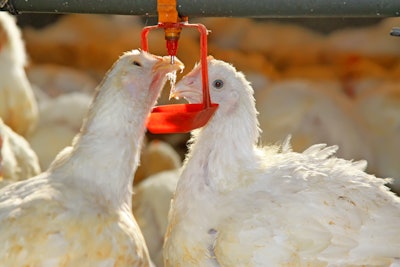
Over the next decade, the world’s population is expected to grow to 8.6 billion people, with an average annual growth rate of 0.9%, according to the latest predictions from the OECD-FAO Agricultural Outlook publication. Population growth is focused on developing regions, specifically Sub-Saharan Africa, which is forecast to grow by 2.6% over the next 10 years (Figure 1).
By 2031, developing countries will increase poultry production by over 22%, while developed countries will grow only by 6% from the average of the period of 2019-21 (Table 1). Similarly, developing countries’ poultry meat consumption growth will be almost triple that of developed countries at 18.92% and 7.44%, respectively.
Globally, poultry meat consumption is projected to increase to 154 million mt (metric tons) by 2031 (Table 1). This is primarily attributed to the population growth and meat preferences of developing countries including China, India, Indonesia, Malaysia, Pakistan, Peru, the Philippines and Vietnam.
Lower income countries’ consumption to increase
The long-term shift in meat consumption toward poultry will continue to strengthen in low- and middle-income countries, the rising trend is due to the population growth and lower price of poultry compared to other meats (Figure 2).
In high income countries, consumption is anticipated to trend slightly lower than production levels given greater dietary concerns and consumers wanting diversity in protein sources. Consequently, the OECD and FAO project that poultry meat will make up 47% of the animal protein consumed over the next 10 years, followed by pig, sheep and bovine.
While all countries are projected to increase poultry meat consumption per capita over the next decade, North America will lead with 49.64 kg, followed by Latin America and Caribbean at 34.91 and Oceania at 34.84 (Figure 3).
HPAI and Ukraine
2022’s highly pathogenic avian influenza (HPAI) outbreak caused major interruptions in the poultry industry for multiple countries. In the U.S., HPAI claimed 2.27 million broilers and 5.28 million turkeys. In Europe, 1,766 HPAI outbreaks were recorded in 2022, based on the July 3rd, 2022, update of the European Commission’s Animal Disease Information System, which deems it the worst ever such epidemic in the bloc.
In addition, the war in Ukraine resulted in major disruptions in the production of wheat, soybeans, corn, barley and sunflower, causing input prices for global the poultry industry to increase.
The war started while Ukraine and the Russian Federation were in the middle of their 2021 and 2022 marketing seasons and has led to a 20-40% increase in grain prices globally, along with increases in transport and logistics costs. However, higher prices at the shelves will continue to help the poultry industry remain profitable in the face of higher input costs. The even higher costs associated with producing other animal proteins will give poultry meat a comparative cost advantage.
Poultry meat consumption in developed countries 2022-31
Projected population growth by region, millions 2022-31
Poultry meat production in developing countries 2022-31
Poultry meat consumption in developing countries 2022-31
Projected annual population growth by region, percent change 2022-31


















